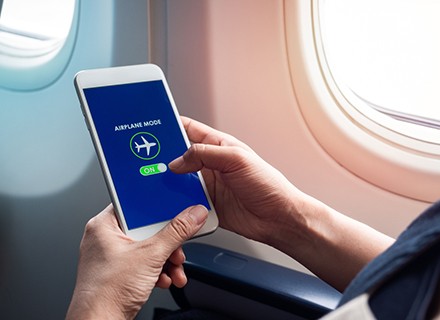The crew or the aircraft pilot will offer the passengers a variety of instructions before they board the plane. The warning covers various travel-related topics, including emergency door usage and orientation. How is the seatbelt fastened? How to act in an emergency, among other things. One of the most important recommendations is to turn off or put your phone in aeroplane mode. Most people believe this is a step they don’t need to take. Is it really that unimportant, though? We respond to the query. Here are some excellent reasons to travel with your plane in aeroplane mode.
Obstruction in the plane’s communication
Radio services are essential for aviation navigation and communication and have been integrated since the 1920s to reduce interference. Even 60 years ago, some of the older analogue technologies we employed were far less sophisticated than the digital technology that is currently in use.
According to research, personal electronics can emit a signal in the same frequency range as the aircraft’s navigation and communications systems, which results in electromagnetic interference.
However, a 1992 independent investigation by the US Federal Aviation Authority and Boeing into the usage of electronic devices on aeroplanes showed no interference problems with computers or other personal electronic devices during non-critical stages of flight.
To prevent interference between different uses, such as mobile phones and aviation navigation and communications, the US Federal Communications Commission has started to construct designated frequency bandwidths. Governments created the same procedures and laws worldwide to avoid aviation interference issues. Since 2014, electronic devices have been permitted to be left on throughout the European Union.
Why do flights ask you to turn on aeroplane mode?
Why does the aviation sector still prohibit using mobile phones despite these international standards? One of the issues is something you might not anticipate. A ground disturbance.
A system of towers links wireless networks. People who use their phones while flying over these ground networks might become overloaded. Over 2.2 billion people travelled in 2021, less than half the number of people who travelled in 2019. So the wireless providers might be right in this case.
Of course, adopting a new standard has been the most significant recent shift in mobile networks. Many in the aviation business are concerned about the current 5G wireless networks, coveted for faster data transfer.
Even though radio frequency bandwidth is constrained, we continue to attempt to integrate new devices. For example, according to the aviation sector, the 5G wireless network bandwidth spectrum is exceptionally close to the designated bandwidth spectrum, which could interfere with navigation equipment adjacent to airports that helps with landing.
Airport operators in Australia and the US have expressed worries about implementing 5G for aviation safety, but it seems to have gone off without a hitch in the European Union. In either case, it is wise to restrict mobile phone use on aeroplanes while problems with 5G are resolved.
In the end, we must not forget air anger. Nowadays, most airlines provide their passengers with free or pay-per-use Wi-Fi services. Passengers might conceivably use their mobile phones to do video chats with friends or clients while in flight, thanks to improved Wi-Fi technologies.
If everyone were making calls, the in-flight service would take longer to complete on an aeroplane with more than 200 passengers. Therefore, some people could think that the issue with cell phone use while flying is primarily related to the crowded social environment created by the possibility of simultaneous conversation among 200+ passengers.
In an era where disruptive passenger behaviours, such as “air rage,” are becoming more common, using a phone while flying could be another catalyst that alters the flight experience. Disruptive behaviour can take many forms, from disregarding safety regulations like not buckling up to violent altercations with other passengers and crew members, often referred to as “air rage.”
In conclusion, using a phone while flying does not now compromise the plane’s ability to fly. Although there are a lot of customers to serve, cabin workers might wish to avoid delays in helping them. We’ll need more research to address the 5G question regarding interference with aircraft navigation during landings because 5G technology is encroaching on the radio bandwidth of aircraft navigation systems.


